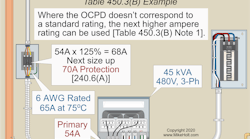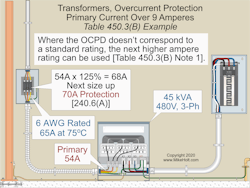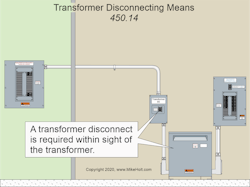Courtesy of www.MikeHolt.com. Based on the 2020 NEC.
Article 450 of the National Electrical Code (NEC) opens by saying, “This article covers the installation of all transformers.” Then it lists eight exceptions. So, what does it really cover?
Essentially, this Article covers transformers supplying power and lighting loads. For the purposes of Art. 450 only, a transformer is an individual power transformer (single- or 3-phase,)identified by a single nameplate — unless otherwise indicated.
A major concern with transformers is preventing overheating. The Code does not completely address this issue. Article 90 explains that the NEC is not a design manual, and it assumes that anyone using the Code has a certain level of expertise. Proper transformer selection is an important part of preventing transformers from overheating. The NEC assumes you have already selected a transformer suitable for the load characteristics.
Article 450 then takes you to the next logical step — providing overcurrent protection and the proper connections. But it does not stop there; Sec. 450.9 provides ventilation requirements, and Sec. 450.13 contains accessibility requirements.
Part I contains the general requirements (such as guarding, marking, and accessibility), and Part II contains requirements for specific types of transformers.
Overcurrent protection for transformers not over 1,000V
Transformers having a secondary voltage not exceeding 1,000V, with primary overcurrent protection only, must have the primary overcurrent protective device sized per the percentages shown in Table 450.3(B) and the percentages mentioned in its applicable notes [Sec. 450.3(B)].
Note 1 of Table 450.3(B) says that if 125% of the primary current does not correspond to a standard rating of an overcurrent protective device [Sec. 240.6(A)], the next higher rating is permitted [Sec. 240.6(A)].
Let’s show how this all works through an example problem.
Question
What size primary-only protection overcurrent device and conductor is required for a 45kVA, 3-phase, 480V transformer that is fully loaded? The terminals are rated 75°C (Fig. 1).
(a) 70A breaker, 6 AWG conductor
(b) 100A breaker, 3 AWG conductor
(c) 110A breaker, 2 AWG conductor
(d) 125A breaker, 1 AWG conductor
Solution
Step 1: Determine the primary current.
I = VA ÷ (E × 1.732) I = 45,000VA ÷ (480V × 1.732) I = 54A
Step 2: Determine the primary overcurrent protection rating [Sec. 240.6(A)].
Primary Overcurrent Protection = 54A × 125% = 68A; use the next size up, 70A [Sec. 240.6(A) and Table 450.3(B) Note 1]
Step 3: Determine the conductor size.
The conductor must be sized to accommodate the 70A primary overcurrent protection per Sec. 240.4(B).
Primary Conductor = 6 AWG conductor rated 65A at 75°C [Sec. 110.14(C)(1)(a)(3) and Table 310.16]
Answer
In this example, a 70A breaker and 6 AWG conductor will meet Code requirements.
According to Note 1 of Table 450.3(B), transformers having a primary current rating of 9A or more are permitted to use the “next size up” rule when 125% of the primary current doesn’t correspond to the standard rating of a fuse or nonadjustable circuit breaker listed in Sec. 240.6(A). This Note does not require the next size up protection; it “permits” the next size up.
Setting it in place
Always install transformers per the manufacturer’s instructions and ensure transformer ventilating openings are not blocked by walls or other obstructions [Sec. 450.9]. Pay attention to other equipment that is (or will be) installed in the same room (or close to the transformer if in an open area).
Some general tips:
- Never set two transformers with their vents facing each other.
- Don’t install a transformer with the vent facing a distribution panel, cable rack, or other equipment that needs cool air.
- Don’t install a transformer below a water heater that is on a mezzanine or similar elevation.
- If the intended location of the transformer will violate the adequate working space rules, fail to allow for adequate ventilation, or pose some other hazards, do not install the transformer in that location.
- Transformer top surfaces that are horizontal and readily accessible must be marked to prohibit storage on those surfaces.
- You don’t want a person standing in the transformer vent path to reach a fire extinguisher. So, if the transformer vents face a beam-mounted or wall-mounted fire extinguisher, remove the extinguisher — and remount it on something that is out of the vent exhaust path. Mark the new location the same way the old location was marked; if the old location was not marked, clearly mark the new location using a permanent and acceptable means.
- If the transformer will be set where forklifts might be present, ensure someone installs the correct protection (such as a bollard set into the floor). If a bollard will be installed, ensure there will be enough space on the bollard side of the transformer for maintenance and repair.
If a vented dry-type transformer is installed in an equipment room with a door:
- Ensure the room is vented either via door vents that cannot be blocked or (preferably) an exhaust vent to the outside. Adding an air intake vent and then adding a fan in the exhaust ducting will make the room more tolerable for both the transformer(s) and the electricians working in that room.
- If the door is an inswing type, ensure the opened door will not block the transformer vent. If someone props the door open (for example, because the room is hot and they need to work in there), and the inswing door blocks the vent of a transformer, that transformer is more likely to overheat.
- It may be tempting for some people to use that room as a storage area. Make a written request to the facility manager to affix a sign to the door, and hang another sign inside the room stating it’s not a storage area. Also, suggest that card access to the room be granted only to people who fit OSHA’s definition of a “qualified worker” per the equipment inside the room. This prevents the equipment from being readily accessible to people in general and is a good safety measure.
Grounding and bonding
A terminal bar for equipment grounding conductors (EGCs), system bonding jumpers, supply-side bonding jumpers, and grounding electrode conductors (GECs) must be installed and bonded inside the transformer enclosure [Sec. 450.10(A)].
Nonconductive coatings on transformer enclosures must be removed to ensure electrical continuity, or the termination fittings must be designed to make such removal unnecessary [Sec. 250.12].
Power quality problems can occur because of incorrectly grounding and bonding a transformer. You can never fix power quality problems by introducing grounding or bonding errors at the transformer or anywhere else. But you can reduce or eliminate power quality problems by correcting grounding and bonding errors at the transformer or somewhere else (e.g., at the utilization equipment).
Transformer accessibility
Transformers must be readily accessible to qualified personnel for inspection and maintenance [Sec. 450.13]. Notice the language is “accessible to qualified personnel.” This in no way inhibits making transformers inaccessible to unqualified personnel.
Two exceptions to the “make readily accessible” rule are noted in Sec. 450.13(A) and (B):
(A) Open Installations. Dry-type transformers having a secondary voltage of 1,000V or less are not required to be readily accessible.
(B) Suspended Ceilings. Dry-type transformers having a secondary voltage of 1,000V or less and not more than 50kVA can be installed above a suspended ceiling.
Disconnecting means
A transformer must have a disconnect within sight of the transformer unless the disconnect location is field marked on the transformer, and the disconnect is capable of being locked in the open position per Sec. 110.25 [Sec. 450.14] (Fig. 2).
“Within sight” means it is visible and not more than 50 ft from the equipment [Art. 100].
You can use the breaker that supplies the transformer primary as the disconnecting means. Alternatively, you can also use a properly rated safety switch.
Go beyond the NEC
Much of what we’ve discussed here isn’t explicitly required by the NEC. For example, most of the general tips for setting it in place are not found in the NEC. But these and similar recommendations are the kinds of best practices that improve the performance, reliability, and safety of a transformer over its lifetime.
Oddly enough, you will find the underlying concept in NFPA 70E, Standard for Electrical Safety in the Workplace. If you substitute “installation quality” for “personal safety risk,” you could use Figure F.1 of Informative Annex F to identify and correct potential problems with the installation.
Figure F.1 has you start by establishing the context. Step back from the transformer installation task itself, and look at the context — that is, see the forest and not just the tree you are working on. Is this in a room with an inswing door? Is other equipment in there? What might block airflow? What else can you see that might impinge upon a safe and reliable installation?
These materials are provided by Mike Holt Enterprises in Leesburg, Fla. To view Code training materials offered by this company, visit www.mikeholt.com/code.







